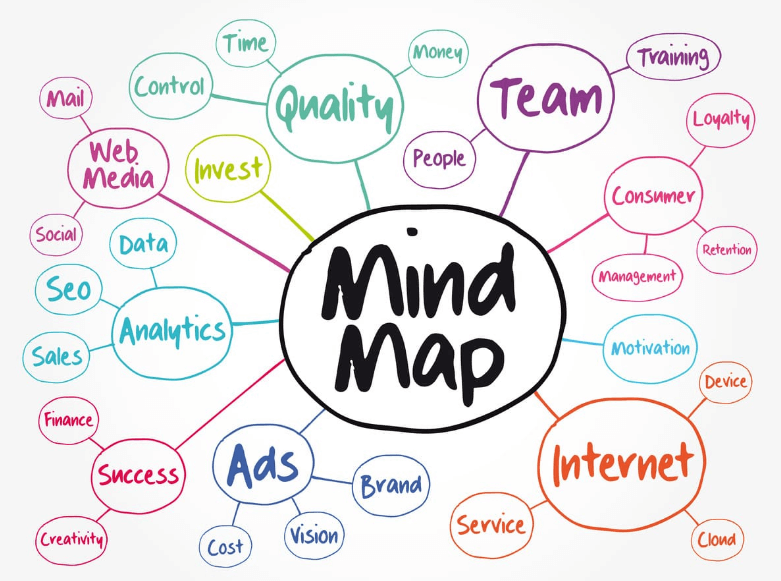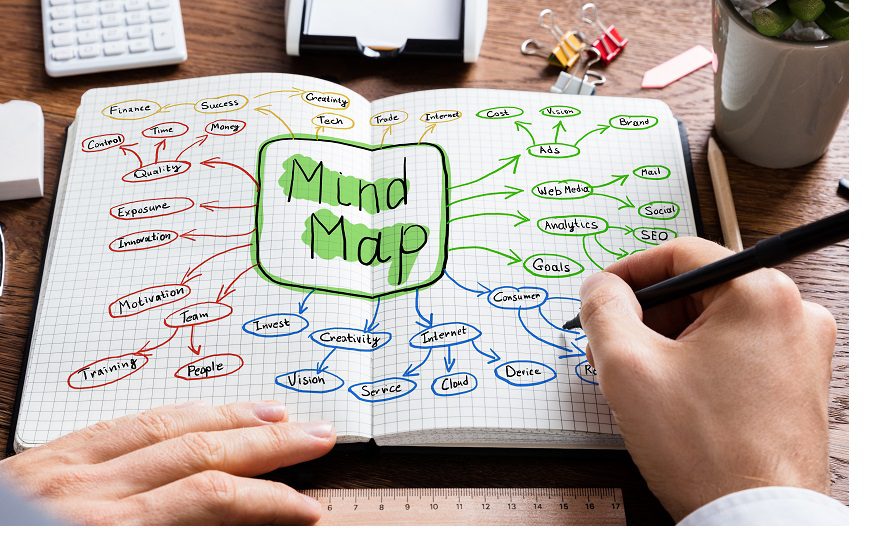Mind maps are powerful tools that help individuals organise thoughts, solve problems, boost creativity, and improve memory. Whether you’re a student preparing for exams, a professional planning a project, or someone who simply wants to think more clearly, creating mind maps the right way can make a big difference.
This blog will walk you through the right way to create mind maps, offering a step-by-step guide and practical tips to ensure your mind maps are effective and easy to use.

What Is a Mind Map?
A mind map is a visual diagram that organises information around a central idea using branches and sub-branches. Each branch represents a related concept, helping to break down complex ideas into more manageable parts. Invented by Tony Buzan in the 1970s, mind maps mimic how the brain works—associatively and visually, making them more intuitive than linear note-taking methods [1].
Mind maps can be drawn by hand or created using digital tools like MindMeister, XMind, or Canva. The purpose is the same: to see the big picture and the details all at once.
Why Use Mind Maps?
Mind maps are more than just colourful drawings. They are scientifically backed tools for:
- Improving memory – Visual cues help our brains remember information more effectively.
- Enhancing creativity – Non-linear thinking encourages idea generation.
- Boosting productivity – Tasks and ideas are easier to organise and prioritise.
- Supporting learning – Helps students summarise and understand large volumes of information.
Studies have shown that using mind maps can improve learning outcomes by up to 15% compared to traditional note-taking methods .
Step-by-Step: The Right Way to Create a Mind Map
Here’s how to create a mind map effectively, no matter your age or skill level:
1. Start with a Central Idea
Begin your mind map by writing the main topic or problem in the centre of your page or screen. This could be anything from “Biology Exam Revision” to “Business Plan” or “Personal Goals 2025”.
Make this central idea bold and clear. Use an image or icon if possible—it stimulates the visual cortex and helps reinforce memory.
Tip: Use uppercase letters and bold colours to make the central idea stand out.
2. Add Main Branches
From the central idea, draw thick branches that represent major categories or key points. For a school subject, these might be different chapters. For a business plan, they could be “Marketing”, “Finance”, “Product Development”, etc.
Use keywords instead of full sentences to keep your branches concise. Keywords act as mental triggers for the broader information they represent.
Tip: Stick to 5–7 main branches to avoid clutter.
3. Add Sub-Branches for Details
Each main branch can have smaller sub-branches that represent supporting ideas, details, tasks, or notes. This is where you flesh out your map.
For example, under “Marketing”, sub-branches might include “Social Media”, “Email Campaigns”, “SEO”, and “Budget”.
The more hierarchical your branches, the more organised your mind map becomes.
Tip: Use curved lines instead of straight ones—it makes the map look more organic and easier to follow.
4. Use Colours, Images, and Symbols
Colours and images help distinguish different parts of your mind map and stimulate the brain. Use different colours for each main branch, and feel free to add doodles, emojis, or small pictures to represent ideas.
Symbols like checkmarks, stars, or exclamation points can be used to indicate priority or action items.
Research from the University of Minnesota shows that visuals are processed 60,000 times faster than text. So, a little art goes a long way!
5. Keep It Simple and Clear
Avoid overcomplicating your map. The goal is clarity, not decoration. Keep your words short and readable. If a branch starts to get too crowded, consider splitting it into a new map.
A good mind map should be easy to glance at and understand in seconds.
Tip: If using digital tools, use the zoom and collapse features to keep your workspace tidy.
Common Mistakes to Avoid
- Overloading with information: Stick to keywords; don’t write essays in your branches.
- Using uniform colours: Differentiation is key to creating mental associations.
- Forgetting the hierarchy: Make sure your main ideas are prominent, and details are subordinate.
- Making it too linear: The point of a mind map is to explore connections, not to write in order.
Mind Maps for Different Age Groups
One of the best things about mind maps is that anyone can use them, regardless of age:
- Children: Mind maps can help with learning vocabulary, summarising stories, or planning essays. Use pictures and lots of colours to keep it engaging.
- Teenagers/Students: Great for exam preparation, essay planning, and project research. Digital mind mapping apps are especially useful here.
- Adults: Ideal for brainstorming, setting goals, managing time, and professional development. Mind maps also help in meetings, presentations, and strategic planning.
- Seniors: Using mind maps for hobbies, travel planning, or journaling can stimulate cognitive function and memory retention.
Digital vs. Paper Mind Maps
Paper mind maps are tactile and easy to create. They’re ideal for creative sessions, teaching kids, or when you want to be free of screens.
Digital mind maps, on the other hand, are perfect for professional use. They allow easy editing, sharing, and collaboration. Some tools even allow for team brainstorming, file attachments, and cloud storage.
Top digital tools include:
- MindMeister
- XMind
- Miro
- Canva Mind Maps
- Lucidchart
Choose the method that best suits your goals and preferences.
Using Mind Maps in Everyday Life
Mind maps aren’t just for work or school. Here are some everyday uses:
- Grocery shopping: Organise by aisle or food group.
- Meal planning: Plan weekly meals and ingredients.
- Holiday planning: Organise destinations, to-do lists, and travel details.
- Self-reflection: Explore your goals, fears, and growth areas visually.
You can also use mind maps as a form of visual journaling to track moods, habits, or affirmations.
Final Thoughts
Creating a mind map the right way is less about rules and more about structure and purpose. When used correctly, mind maps can unlock your creativity, clarify your thinking, and make learning or organising a lot more enjoyable.
Whether you’re drawing one by hand or using a high-tech app, the key is to keep it visual, simple, and personal.
So next time you feel overwhelmed by ideas or tasks, try a mind map—you might just be surprised at how much clearer things become.
The Right Way to Maintain Healthy Boundaries
References
- Buzan, T. (1993). The Mind Map Book. BBC Books.
- Farrand, P., Hussain, F., & Hennessy, E. (2002). “The efficacy of the ‘mind map’ study technique.” Medical Education, 36(5), 426–431.
- University of Minnesota. (2009). “Visual Communication Facts and Figures.” Retrieved from https://www.researchgate.net/publication/228920215

